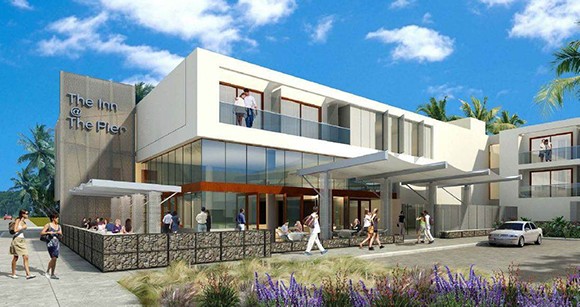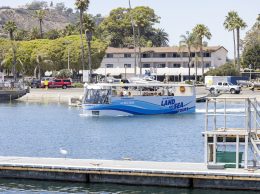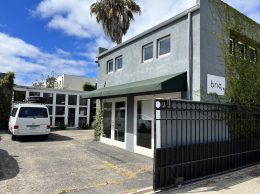South Coast firms launch statewide hotel building spree with Pismo project
IN THIS ARTICLE
- Central Coast Topic
- Elijah Brumback Author
By Elijah Brumback Friday, June 13th, 2014

A rendering for the Inn at the Pier in Pismo Beach. (courtesy image)
Two Santa Barbara firms are backing a 30-year veteran of the hospitality development market and his plans to build out hotels along the California coast, with the first test project taking shape in Pismo Beach.
“We’re working on several other opportunities and actively looking for properties within our focus,” said Dana Severy, president of Postcard Properties, which is working with Somera Capital Management on hotels in Pismo Beach and Avila Beach. “We’re targeting proven resort locations with a drive-to relationship to the Bay Area or Southern California.”
Napa Valley, Sonoma, Lake Tahoe and the Eastern Sierra region of the state are among the other areas where the firms are looking to build out Severy’s hospitality development model.
Destination properties are popular investments as the tourism and wine industries fuel developer confidence, according to Chris Richardson, managing partner of San Luis Obispo-based Richardson Properties. Richardson brokered both the Pismo and Avila Beach land deals.
“With land cost and improvement costs buoyed by the economic recovery, projects are viable again,” Richardson said. “While things really started to pick up last year, it’s carried through to this year and has been relatively gradual.”
The Pismo and Avila Beach projects are the start of what Postcard’s Severy said is a plan to develop a “constellation” or collection of properties along the California coast. Eventually, the goal is to have a number of affordable lodging properties in proven destination markets and all within driving distance of major metropolitan areas between the Bay Area and Southern California.
“We’re very focused on building this collection, and Pismo is going to be the first project out of the hopper,” Severy said. “With the collection, the idea is to build in a number of synergies and operational efficiencies.”
The target market
Under the Postcard model, which Severy started putting together through the recession, vacationers targeted are primarily families and budget travelers looking to get more bang for their buck. Instead of jetting off to Hawaii as they might have in years past, many travelers are loading up the car and driving a few hundred miles to destinations closer to home, Severy said.
“A lot of people just don’t have the time to commit to vacations like they used to,” he said. “And when the wheels fell off economy and nothing was going on, certainly nothing in the resort world, I went back to researching. … I noticed because of the big haircut a lot a people took, they weren’t buying vacations anymore and they stopped buying the condo on the lake.”
After looking at travel data such as the volume of visitors to state parks, Severy became convinced that his drive-to business model had legs. He started shopping the idea around to various capital partners and finally struck an agreement with Somera, a boutique real estate investment firm that has backed hotel, apartment and office developments throughout the state.
“In looking at potential deals [Somera] can get to ‘yes’ or ‘no’ pretty quickly,” Severy said. “So after some discussions over a few short months, they said, ‘We love this business model,’ and decided to partner up. Once that was established, I focused on the project opportunities that met the bill for what Somera signed up for.”
The search eventually led to the Inn at Pismo Beach project. The $40 million, 108-room hotel is currently winding its way through the planning process, although Severy said he hopes to break ground in early 2015.
The Avila Beach project is further from fruition. Postcard and Somera purchased the 23-acre beachfront site earlier this year from San Luis Obispo County developer Rob Rossi for a reported $2.4 million. At the time of the purchase, Severy told the Business Times that the firms planned to move forward with a boutique, 50-unit cottage-style hotel development.
“The ink is style drying on the Avila deal,” Severy said. “We’re just starting in earnest to plan and we have some months to come up with program that we can use. The Pismo property is really in the cross-hairs, but the good thing is [the firms] have enough bench strength to multitask these projects.”
With a wave of hospitality development washing over SLO County, city business leaders predict there may be growing pains as government officials try to manage concerns from residents with a desire to grow tax revenue.
“We’re really limited because there is only so much space that’s available and that means if we want to keep growing, we’ll have to annex land or [build] up,” said Peter Candela, CEO of the Pismo Beach Chamber of Commerce. “I think the annexation of Price Canyon is going to be crucial. We’re getting really close to maxing out and we really need to look at that expansion.”
Annexation of the Price Canyon area faces strong opposition from slow-growth groups and residents who are concerned that Spanish Springs, a proposed 961-acre hospitality, commercial and residential compound, will ruin Pismo Beach’s idyllic character.
“Some locals don’t want growth,” Candela said. “But we have City Council people that really look into projects to see if it really benefits the community as a whole. It’s not just pure dollars and cents.”
Candela said if he were a developer, now is the time to get projects running through the development process.
The city is eager to grab its share of the hospitality boom. Tourists generate hotel bed taxes and sales taxes for cities.
“We’re thrilled to see more projects come online,” said Pismo Beach City Manager James Lewis. “The challenge is making sure we create unique spaces that resident can enjoy all year round. From the residents’ standpoint, they’ll live with these building year in and year out, and it’s important we make them attractive compliments to the community with amenities that everyone can take advantage of.”
A closer look: Inside the strategy
Postcard Properties plans to create an independently owned and operated collection of lodging properties in popular locations along the Central Coast. In total, Severy envisions a portfolio of about 10 to 12 properties, he told the Business Times.
The model is based on a “culture of thrift” and a “back to basics” sensibility as a result of the recession with travelers taking more modest vacations closer to home, he said. At the same time, the proximity to the San Francisco and Los Angeles markets also provides opportunities to capture a growing number of foreign visitors to the the state, he said.
Currently, there isn’t a commonly owned collection of three- to four-star hotels along the California coast, Severy said, a gap the firm would like to fill with its properties. This could give the firm the strategic competitive advantages to grow through economies of scale and marketing synergies stand-alone properties can’t leverage, he said.
Going forward, acquisitions and the redevelopment of existing properties as well as ground-up development of new hotels are the various ways Postcard will build the collection.
“We will grow through carefully considered and conservatively underwritten acquisitions and joint ventures” Severy said.
Related Articles
 Sunday, August 21st, 2022
Sunday, August 21st, 2022










